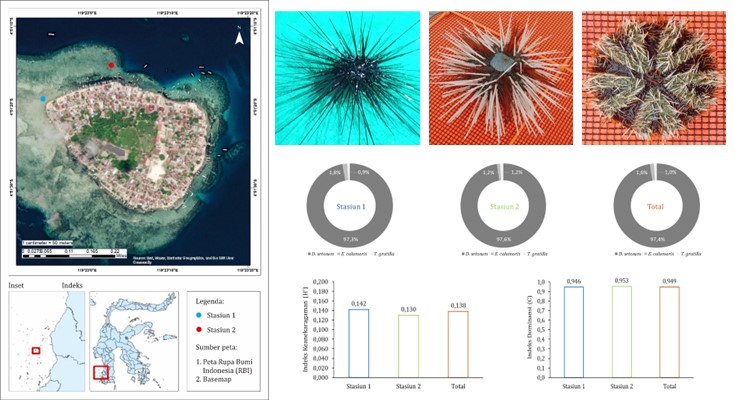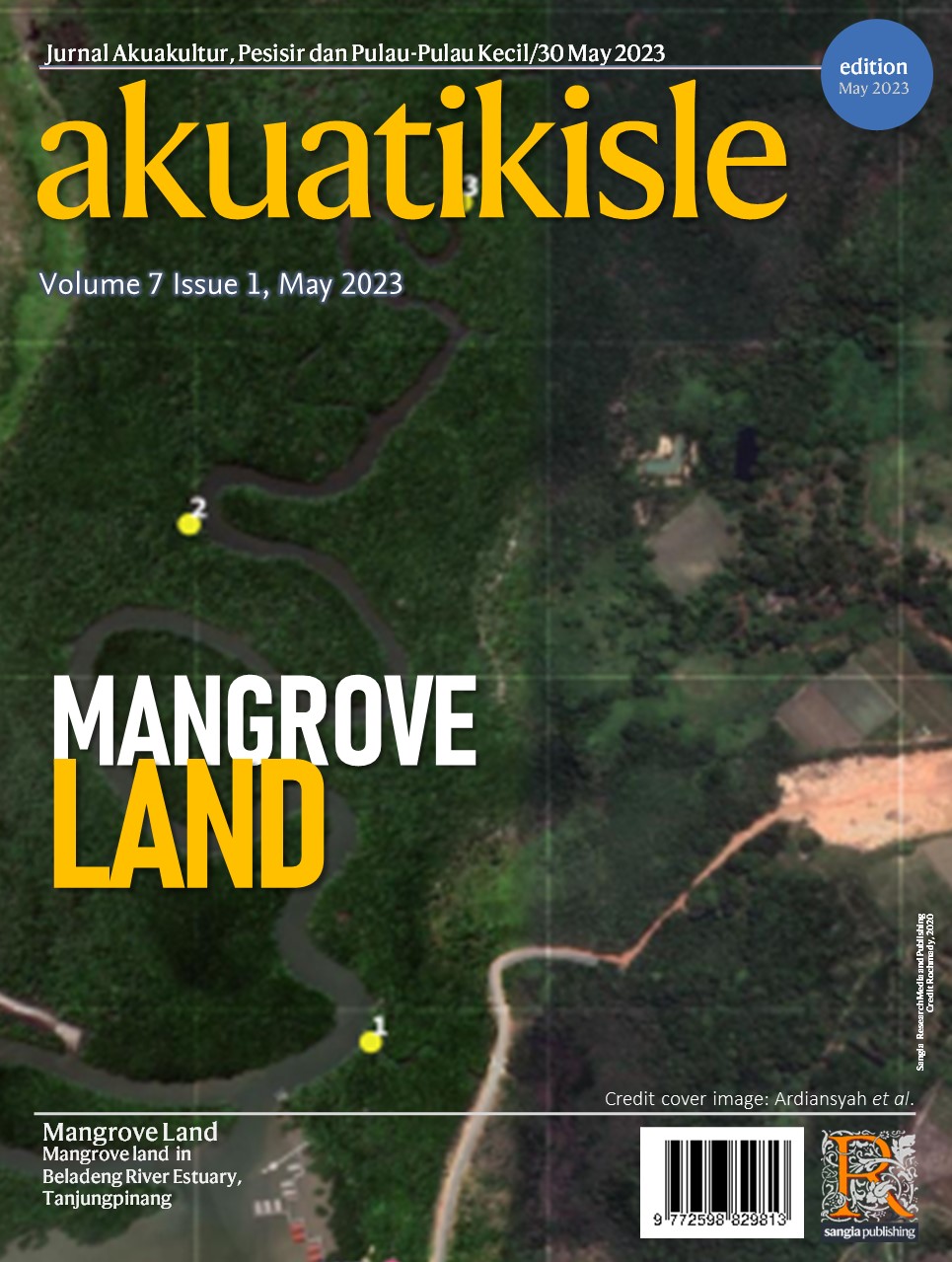Akuatikisle: Jurnal Akuakultur, Pesisir dan Pulau-Pulau Kecil
Full Length Article
Sea urchins in the intertidal zone on Karanrang Island, Pangkep Regency; Density, abundance, community structure, and distribution patterns
Highlights
Generate NLP AI by Wizdam ID.
Abstract
Sea urchins were ecologically and economically important biota, but scientific information on sea urchins is still very minimal and there is no ongoing monitoring. The purpose of this study was to determine the density, abundance, community structure, and distribution patterns of sea urchins in the intertidal zone of Karanrang Island, Pangkep Regency. The research in June-July 2022 was carried out at high and low tide using three transects measuring 1 x 1 m consisting of four plots measuring 50 x 50 cm. Determination of stations based on information from local residents to get observation stations based on tidal conditions. The results showed that three species of sea urchins from two families were found, namely Diadema setosum, Echinothrix calamaris, and Tripneustes gratilla. The species of D. setosum was found to be very abundant (97.3-97.6%) and tended to be more abundant during high tide than during low tide. The index of diversity and uniformity of porcupine species is low (H' = 0.130-0.142 and E = 0.118-0.129). The species dominance index was in the range of 0.946-0.953 indicating high dominance of D. setosum. Spatially, D. setosum had a uniform distribution pattern, whereas E. calamaris and T. gratilla were distributed in clusters. Further spatial and temporal research is needed to comprehensively determinant the conditions of the sea urchin population on Karanrang Island, Pangkep Regency.
Keywords
Introduction
Section snippets
Material and Methods
Materials and methods from the full-text PDF of this article cannot be displayed.
Results
Results from the full-text PDF of this article cannot be displayed.
Discussion
Discussion from the full-text PDF of this article cannot be displayed.
Conclusions
Conclusions from the full-text PDF of this article cannot be displayed.
Acknowledgment
Acknowledgment from the full-text PDF of this article cannot be displayed.
Competing interest
The authors declare that they have no known competing financial interests or personal relationships that could have appeared to influence the work reported in this paper.
Conflict of interest
The authors declare that the research was conducted in the absence of any commercial or financial relationships that could be construed as a potential conflict of interest.
Ethical approval acknowledgements
No ethical approval required for this article. All procedures followed were in accordance with the ethical standards of the responsible committee on human experimentation (institutional and national) and with the Helsinki Declaration of 1975, as revised in 2008 (5)
Supplementary files
Data sharing not applicable to this article as no datasets were generated or analysed during the current study, and/or contains supplementary material, which is available to authorized users.
References (1)
Alwi, D., Muhammad, S. H., & Tae, I. 2020. Karakteristik morfologi dan indeks ekologi bulu babi (Echinoidea) di Perairan Desa Wawama Kabupaten Pulau Morotai. Jurnal Sumberdaya Akuatik Indopasifik, 4(1), 23. https://doi.org/10.46252/jsai-fpik-unipa.2020.vol.4. no.1.95
Amrullah, A. 2014. Analisis kondisi terumbu karang di Perairan Kecamatan Liukang Tuppabiring Kabupaten Pangkep Sulawesi Selatan dengan pendekatan remote sensing (penginderaan jauh). Jurnal Biotek, 2(1), 1–14.
BPS. 2022. Kecamatan Liukang Tupabbiring Utara dalam Angka 2022. BPS Kabupaten Pangkep. http://journal.um-surabaya.ac.id/ index.php/JKM/article/view/2203
Brower, J., Zar, J., & Ende, C. Von. 1998. Field and Laboratory Methods for General Ecology. New York: The McGraw-Hill companies.
Davidson, T. M., & Grupe, B. M. 2015. Habitat modification in tidepools by bioeroding sea urchins and implications for fine-scale community structure. Marine Ecology, 36(2), 185–194. https://doi.org/10.1111/maec.12134
Filbee-Dexter, K., & Scheibling, R. E. 2014. Sea urchin barrens as alternative stable states of collapsed kelp ecosystems. Marine Ecology Progress Series, 495(March 2015), 1–25. https://doi.org/10.3354/meps10573
Fitriyani, F., Santoso, D., & Karnan, K. 2022. Abundance and distribution patterns of sea urchins (Echinoidea) at Lakey Beach, Hu’u District, Dompu Regency. Jurnal Biologi Tropis, 22(1), 277–288. https://doi.org/10.29303/jbt.v22i1.3119
Grosso, L., Rakaj, A., Fianchini, A., Morroni, L., Cataudella, S., & Scardi, M. 2021. Integrated Multi-Trophic Aquaculture (IMTA) system combining the sea urchin Paracentrotus lividus, as primary species, and the sea cucumber Holothuria tubulosa as extractive species. Aquaculture, 534(December), 736268. https://doi.org/ 10.1016/j.aquaculture.2020.736268
Haarpaintner, J., & Davids, C. 2021. Mapping atmospheric exposure of the intertidal zone with sentinel‐1 csar in northern Norway. Remote Sensing, 13(17). https://doi.org/10.3390/rs13173354
Hadinoto, S., Sukaryono, I. D., & Siahay, Y. 2017. Kandungan gizi gonad dan aktivitas antibakteri ekstrak cangkang bulu babi (Diadema setosum). JPB Kelautan Dan Perikanan, 12(1), 71–78.
Hasan, M. H. 2019. Distribution patterns and ecological aspects of the sea urchin Diadema setosum in the Red Sea, Egypt. Mohamed Hamza Hasan Faculty of Fish Resources, Suez University, Egypt. Egyptian Journal of Aquatic Biology & Fisheries, 23(4), 93–106.
Haurissa, J., Lutfi, L., & Toha, A. H. A. 2021. Struktur komunitas bulu babi (Echinoidea) di zona intertidak Perairan Manokwari. Jurnal Kelautan: Indonesian Journal of Marine Science and Technology, 14(2), 132–142. https://doi.org/10.21107/jk.v14i2.10834
Heriansah, Nursyahran, Nursidi, Nursida, N. F., & Najamuddin. 2021. Practical application of sea urchin shell flour supplementation as a stimulant moulting in vannamei shrimp. DEPIK Jurnal Ilmu-Ilmu Perairan, Pesisir Dan Perikanan, 10(2), 107–114. https://doi.org/ https://doi.org/10.13170/depik.10.2.19456
Heriansah, Syamsuddin, R., Najamuddin, & Syafiuddin. 2022. Growth of Kappaphcus alvarezii in vertical method of multi-trophic system based on feeding rate. Egyptian Journal of Aquatic Biology and Fisheries, 26(5), 1197–1210. https://doi.org/10.21608/ ejabf.2022.267643
Krebs, C. . 1985. Ecology: The Experimental Analysis of Distribution and Abundance. Haeper and Row Publisher, New York.
Lubis, S. A., Yolanda, R., Purnama, Anthonius, A., & Karno, R. 2016. The sea urchin (Echinoidea) from Panjang Island Water, Bangka Belitung Province. Omni-Akuatika, 12(2), 125–129.
Luparello, C., Ragona, D., Asaro, D. M. L., Lazzara, V., Affranchi, F., Arizza, V., & Vazzana, M. 2020. Cell-free coelomic fluid extracts of the sea urchin arbacia lixula impair mitochondrial potential and cell cycle distribution and stimulate reactive oxygen species production and autophagic activity in triple-negative MDA-MB231 breast cancer cells. Journal of Marine Science and Engineering, 8(4). https://doi.org/10.3390/jmse8040261
Masfuah, M., Suminto, S., & Subandiyono, S. 2020. Pengaruh prosentase tepung cacing tanah (Lumbricus rubellus) dalam pakan buatan dan Chaetoceros calcitrans terhadap performa petumbuhan Oithona similis. Sains Akuakultur Tropis, 4(1), 68–77. https://doi.org/ 10.14710/sat.v4i1.7263
Moka, W., Inaku, D. F., & Rais, M. 2021. Struktur komunitas landak laut di padang lamun Pulau Kodingareng, Kepulauan Spermonde. Jurnal Kelautan Tropis, 24(1), 63–70. https://doi.org/ 10.14710/jkt.v24i1.9320
Moreno-García, D. M., Salas-Rojas, M., Fernández-Martínez, E., del Rocío López-Cuellar, M., Sosa-Gutierrez, C. G., Peláez-Acero, A., Rivero-Perez, N., Zaragoza-Bastida, A., & Ojeda-Ramírez, D. 2022. Sea urchins: an update on their pharmacological properties. PeerJ, 10, 1–19. https://doi.org/10.7717/peerj.13606
Nurdin, N. 2010. Kajian efektifitas kebijakan pada kasus destructive fishing pengelolaan pesisir berbasis masyarakat pada pulau-pulau kecil. Jurnal Bumi Lestari, 10(2), 242–255.
Odum, E. P. 1993. Fundamentals of Ecology. Belmont, CA, Thomson Brooks/Cole.
Paharuddin, P., Kasmi, M., Sulkifli, S., Irawan, I., Makkulau, A. R., & Aman, A. 2022. Implementation of transplantation and restoration development technology as alternative income marine tourism on Karangrang Island Pangkajene Kepulauan South Sulawesi. Mattawang: Jurnal Pengabdian Masyarakat, 3(3), 360–369. https://doi.org/10.35877/454ri.mattawang1226
Parvez, M. S., Rahman, M. A., Yusoff, F., Arshad, A. Bin, & Lee, S.-G. 2018. Studies on the ontogenic development of a high-valued tropical sea urchin, Tripneustes gratilla (Linnaeus, 1758) for seed production and commercial aquaculture. Historical Studies in the Physical and Biological Sciences, 5(February).
Politi, Y., Arad, T., Klein, E., Weiner, S., & Addadi, L. 2004. Sea urchin spine calcite forms via a transient amorphous calcium carbonate phase. Science, 306(5699), 1161–1164.
Pratita, S. D., Gavintri, M. B., Rizkyta, A. N., Khasanah, L. U., Ponkiyawati, F. A., & Retnoaji, B. 2022. Study on the potential of sea urchin Tripneustes gratilla as a bioindicator dangerous plastic pollution in environment of gunungkidul beach Yogyakarta. IOP Conference Series: Earth and Environmental Science, 1036(1).
Purnomo, I. G. P., Darma, I. S., & Putra, I. N. G. 2019. Struktur komunitas dan sebaran bulu babi ( Echinoidea ) di kawasan padang lamun Pantai Serangan , Bali. JMRT, 2(2), 29–33.
Rahman, M. A., Arshad, A., & Yusoff, F. 2015. Captive breeding, seed production, grow-out culture and biomedicinal properties of the commercially important sea urchins (Echinodermata: Echinoidea). International Journal of Advances in Chemical Engineering and Biological Sciences, 2(2). https://doi.org/ 10.15242/ijacebs.c0115074
Ristanto, A., Yanti, A. H., & Setyawati, T. R. 2018. Sea Urchin (Echinoidea) Distribution and Abundance in the Intertidal Zone of Bengkayang Regency. Biosaintifika: Journal of Biology & Biology Education, 10(1), 32–40. https://doi.org/10.15294/biosaintifika.v10i1.9763
Shpigel, M., Shauli, L., Odintsov, V., Ben-ezra, D., Neori, A., & Guttman, L. 2018. The sea urchin , Paracentrotus lividus , in an Integrated Multi-Trophic Aquaculture ( IMTA ) system with fish and seaweed. Aquaculture, 490(March), 260–269. https://doi.org/10.1016/j.aquaculture.2018.02.051
Suryanti, S., Fatimah, P. N. P. N., & Rudiyanti, S. 2020. Morfologi, anatomi dan indeks ekologi bulu babi di Pantai Sepanjang. Buletin Oseanografi Marina, 9(2), 93–103.
Tamti, H., Rappe, R. A., Andy Omar, S. Bin, & Budimawan. 2021. Preliminary assessment of Tripneustes gratilla populations in Seagrass Beds of the Spermonde Archipelago, South Sulawesi, Indonesia. IOP Conference Series: Earth and Environmental Science, 763(1). https://doi.org/10.1088/1755-1315/763/1/012008
Toha, A. H. A., Sumitro, S. B., Hakim, L., Widodo, N., Binur, R., & Anggoro, A. J. I. W. 2017. Review : Biology of the commercially used sea urchin Tripneustes gratilla. Ocean Life, 1(1), 1–10.
Tuwo, A. 1995. Aspek biologi bulu-babi jenis Tripneustes Gratilla di Pulau Kapoposan. Oseana, XX(1), 21–29.
Vimono, I. B., Of, A. R., & Urchln, S. E. A. 2007. Sekilah mengenai landak laut. Oseana, XXXII(3), 37–46.
Westlake, E. L., Bessey, C., Fisher, R., Thomson, D. P., & Haywood, M. D. E. 2021. Environmental factors and predator abundance predict the distribution and occurrence of two sympatric urchin species at Ningaloo Reef, Western Australia. Marine and Freshwater Research, 72(12), 1711–1721. https://doi.org/10.1071/MF21091
Yulianto, H., Damai, A. A., Delis, P. C., & Elisdiana, Y. 2017. Spatial Analysis to Evaluate the Suitability of Seaweed Farming Site in Lampung Bay, Indonesia. Turkish Journal of Fisheries and Aquatic Sciences, 17, 1253–1261.
Zakaria, I. J. 2013. Komunitas bulu babi (Echonoidea) di Pulau Cingkuak, Pulau Sikuai dan Pulau Setan Sumatera Barat. Prosiding Semirata FMIPA Universitas Lampung, 1(1), 381–388.
Ziegenhorn, M. A. 2017. Sea Urchin Covering Behavior: A Comparative Review. In Sea Urchin Covering Behavior: A Comparative Review (Issue Oktober, pp. 19–33). https://doi.org/10.5772/ intechopen.68469
Bibliographic Information
Cite this article as:
-
Submitted
4 March 2023 -
Accepted
5 May 2023 -
Published
7 May 2023 -
Version of record
29 May 2023 -
Issue date
30 May 2023
-
Academic subject
Marine Sciences
Copyright
Sangia Advertisement
Copyright © 2023 Sri Nursyarina Fitri, Hartati Tamti, Mesalina Tri Hidayani, Heriansah. Sangia Research Media and Publishing. Production and hosting by Sangia (SRM™).  This work is licensed under a Creative Commons Attribution-ShareAlike 4.0 International License.
This work is licensed under a Creative Commons Attribution-ShareAlike 4.0 International License.
Disclaimer: All claims expressed in this article are solely those of the authors and do not necessarily represent those of their affiliated organizations, or those of the publisher, the editors and the reviewers. Any product that may be evaluated in this article or claim that may be made by its manufacturer is not guaranteed or endorsed by the publisher.
Comments on this article
By submitting a comment you agree to abide by our Terms and Community Guidelines. If you find something abusive or that does not comply with our terms or guidelines please flag it as inappropriate.










